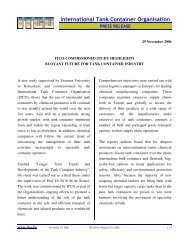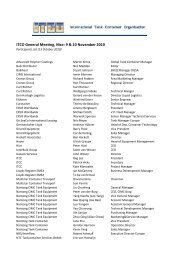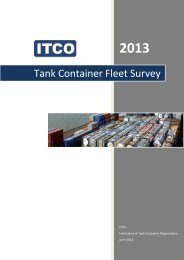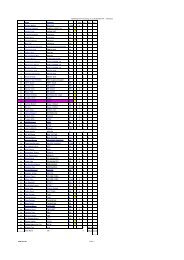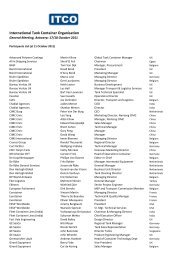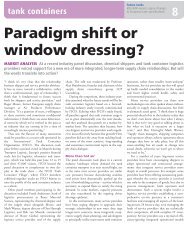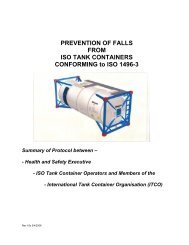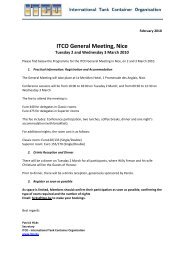You also want an ePaper? Increase the reach of your titles
YUMPU automatically turns print PDFs into web optimized ePapers that Google loves.
ICHCA International <strong>Safe</strong>ty Panel Briefing Pamphlet No 30<br />
10.4.7 Care should be taken when attaching manually operated spreaders used in<br />
a ship’s gear operation using a spring arm and chain system to lock/unlock<br />
could become snagged on the top <strong>of</strong> the tanks<br />
10.5 Internal Movement Vehicles<br />
10.5.1 Only trailers fit for this purpose should be used to transport tank containers<br />
around the terminal.<br />
10.5.2 If using corner less trailers where the design <strong>of</strong> the container is such that the<br />
bottom side rail cannot be fully supported, i.e. for tank containers with a<br />
raised side beam, the tank container should only be carried on such trailers<br />
where they have been specially adapted to ensure the safety <strong>of</strong> operators<br />
and handlers.<br />
10.5.3 Two tank containers may be loaded on suitable trailers, including the corner<br />
less types, provided they do not contain incompatible dangerous goods<br />
11 Stacking Ashore<br />
11.1 See International <strong>Safe</strong>ty Panel Briefing Pamphlet No. 5 Container Terminal<br />
<strong>Safe</strong>ty for more information on stacking and layouts<br />
11.2 All handling locations should have procedures which should include a risk<br />
assessment for receiving and identifying special containers such as tank<br />
containers. The procedures should include special stacking requirements and<br />
cover segregation <strong>of</strong> incompatible goods.<br />
11.2.1 The general segregation principles concerning dangerous goods in the<br />
IMDG Code apply equally to tank containers as to all other containers<br />
carrying dangerous goods and should be followed<br />
11.2.2 <strong>Containers</strong> carrying dangerous goods should not be placed at the end <strong>of</strong><br />
rows where they can be exposed to inter-sectional traffic.<br />
11.3 There are two important messages associated with stacking tank containers:<br />
Not all containers have the same stacking capability as required by ISO<br />
1496/3, and<br />
All containers must be stacked corner fitting to corner fitting.<br />
11.4 The Dangerous or Non Regulated Goods Notes (see Annex 4 Figure A4.2 and<br />
A4.3) should be supplied with the Maximum Superimposed Load shown in box<br />
18c. This value equates to the maximum load that can be placed on top <strong>of</strong> the<br />
container – <strong>of</strong>ten referred to as the stacking capability. For ISO tank containers<br />
the value will be at least 192,000 kg (see section 12.2).<br />
11.5 When developing stacking plans within the risk assessment consideration<br />
should be given to the following:<br />
Ground surface<br />
Surroundings<br />
Segregation<br />
Stack height<br />
Visibility<br />
Accessibility<br />
Stability<br />
Local weather conditions<br />
<strong>Handling</strong> equipment<br />
Human factors<br />
Page 34 ©ICHCA International Limited



